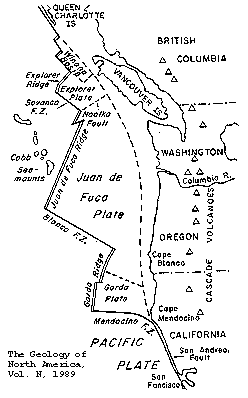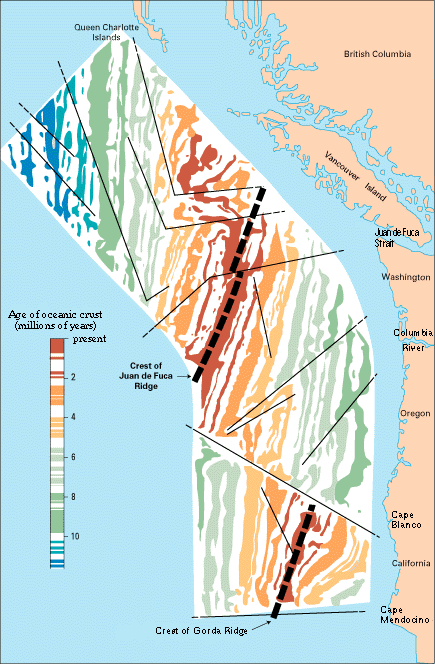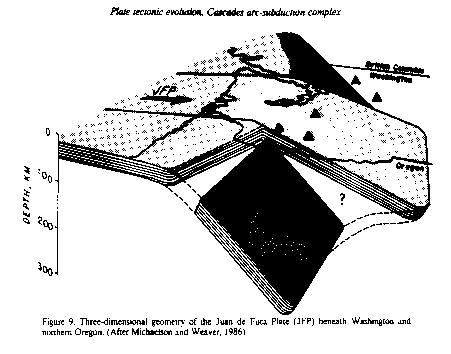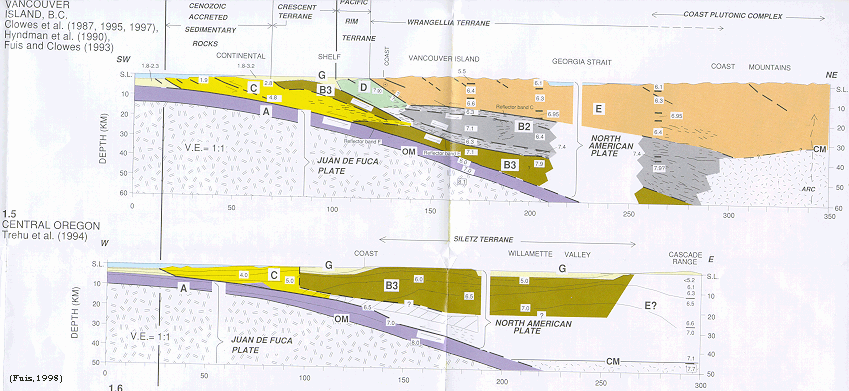
Note the location of the Cascade
Range and the Olympic Peninsula.
The Gorda, Juan de Fuca, Explorer
plates and the respective ridges.
Location and curve of the subduction
zone.
The Juan de Fuca Microplate System
The Juan de Fuca is an interesting area for tectonic research due to several unique characteristics. The Juan de Fuca has all three types of dynamic plate boundaries occurring within a relatively small area. This system consists of a subduction zone along the North American plate at both the Gorda and the Juan de Fuca plates.
The system meets the Pacific plate along a long chain of submarine volcanic divergent zone at the east most boundary. This 500km divergent zone (Brantley, 1994) is composed of three major sea mount ridges (the Gorda, Juan de Fuca, and the Explorer ridges) approximately 8km wide (Brantley, 1994) which feed both the Juan de Fuca microplates to the west and the Pacific plate to the east.
The divergent zone also doubles as a transform zone at the extension of the San Andreas lateral motion along the Mendocino, Blanco, and Sovanco Fracture Zones.

Note the location of the Cascade
Range and the Olympic Peninsula.
The Gorda, Juan de Fuca, Explorer
plates and the respective ridges.
Location and curve of the subduction
zone.
The Juan de Fuca plate currently subducts under
the North American plate with a generalized vector
motion of N50deg.E (Swanson, 1989)
and
with a velocity of 3cm/yr (Noson, Quamar, and Thorsen, 1988). The Gorda
plate subducts with a similar
direction, but at an average velocity of 1.8cm/yr
(Wood
and Kienle, 1990). The Explorer plate is no longer
subducting and is
considered to be a static plate boundary (Wood
and Kienle, 1990). Both the Gorda and the Juan de
Fuca velocities are
considered to be a very slow subduction rates
when compared to global averages.
The convergence rates prior to 7Ma are estimated to be 7-10cm/yr (Wood and Kienle, 1990) with intermittent increases in volcanic activity suggesting that the subduction rates have also varied through time. This current reduction in the convergence rate is believed to be a result of the northward approach of the San Andreas Transform Fault and the Mendocino Triple Junction upon the microplate system.

Note the Pacific-North American plate transform
boundary as the San Andreas Fault,
the Mendocino Triple Junction were the three
plates meet, and
the Juan de Fuca-North American plate subduction
boundary.
Evidence of marine magnetic band orientation indicates that the Juan de Fuca plates are twisting clock-wise into the subduction zone (Atwater, 1970). This effect conflicts with the oblique subduction under the North American plate fed by the divergence of the Juan de Fuca ridges.

Note the subduction zone, orientation of the
magnetic banding,
the youngness of the rocks, and the oceanic volcanic
ridges.
The slow rate of convergence has produced several interesting geographic and geologic features. The subduction zone does not have a recognizable trench (Wood and Kienle, 1990). This is most likely caused by the slow subduction action and the environmental conditions of the Pacific Northwest. Average rainfall in the Pacific Northwest is high and the deposition of erosional systems surpasses the subduction draw.
Most subduction zones have significant seismic activity. The slow rate of convergence of the Juan de Fuca-North American plates is attributed with the low frequency of seismic events. The Pacific Northwest and particularly the area west of the Cascade Range has large but infrequent earthquakes originating at depths of 70-90km. The Olympic earthquake (7.1) of 1949 and the Seattle-Tacoma (6.5) of 1965 were both deep and large magnitude (Noson, Quamar, and Thorsen, 1988). However, the infrequency of seismic activity has made imaging the subducting plate difficult and inaccurate.
Another contributing factor for the infrequency of seismic activity is the proximity of the spreading center to the subduction zone. This nearness of the spreading center subducts warm non-rigid oceanic crust into the lithosphere. The lack of rigidity of the crust is contributes to a more plastic and conformable subduction plate.
This subduction plate is believed to have several strike and dip angles along the curve of the subduction extent. This contortion of the plate is supported by the volcanic response of the Cascade Range. The Cascade Range mirrors the subduction zone except for a 90km gap between Mount Rainier and Glacier Peak were which is volcanically inactive (Swanson, 1989).

Note the location of the Cascade
Range and the two range lineaments.
The location of the Olympic Peninsula
in relation to the range lineaments
and the curve in the subduction
zone.
The shape of the subducting plate at the bend in the subduction zone is an issue of significant controversy. One explanation is that the normal dip of the Juan de Fuca plate (~65deg) (Swanson, 1989) at the point subduction zone bend has a shallow angle of dip (11-40deg). This would push the solid plate deeper into the continental interior. The Olympic Mountain Range is a wedge of oceanic sediment that also supports the shallow dip at the bend area in the subduction zone.

Note the subduction angles with respect to surface
location.

In Conclusion, the Juan de Fuca microplate system is unique due to the location of all three dynamic plate margins in close proximity. This proximity creates geographical and geological features which are anomalous to ambient tectonic averages.
Swanson, 1989, Cenozoic Volcanism in the Cascade Range and Columbia Plateau, Southern Washington, and Northernmost Oregon: AGU Field Trip Guidebook T106.
Brantley, 1994, Volcanoes of the U.S.: USGS General Interest Publication
Noson, Qamar, and Thorsen, 1988, Washington State Earthquake Hazards: Washington State Department of Natural Resources, Washington Division of Geology and Earth Resources Information Circular 85
Wood and Kienle, 1990 Volcanoes of North America: U.S. and Canada: Cambridge University Press
Fuis G. Tectonophysicis, 1998, West Margins of North America, a Synthesis of recent Seismic Transects
Duncan and Kulm, 1989, The Geology of North America Vol. N, The Eastern Pacific Ocean and Hawaii: The Geological Society of America, 1989